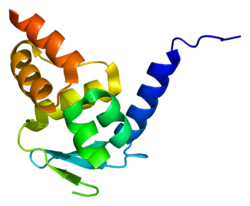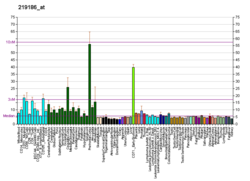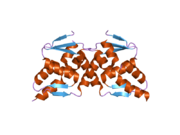ZBTB7A
Zinc finger and BTB domain-containing protein 7A is a protein that in humans is encoded by the ZBTB7A gene.[5][6][7]
Interactions
ZBTB7A has been shown to interact with BCL6.[8]
See also
References
- ^ a b c GRCh38: Ensembl release 89: ENSG00000178951 – Ensembl, May 2017
- ^ a b c GRCm38: Ensembl release 89: ENSMUSG00000035011 – Ensembl, May 2017
- ^ "Human PubMed Reference:". National Center for Biotechnology Information, U.S. National Library of Medicine.
- ^ "Mouse PubMed Reference:". National Center for Biotechnology Information, U.S. National Library of Medicine.
- ^ Morrison DJ, Pendergrast PS, Stavropoulos P, Colmenares SU, Kobayashi R, Hernandez N (Apr 1999). "FBI-1, a factor that binds to the HIV-1 inducer of short transcripts (IST), is a POZ domain protein". Nucleic Acids Res. 27 (5): 1251–62. doi:10.1093/nar/27.5.1251. PMC 148309. PMID 9973611.
- ^ Davies JM, Hawe N, Kabarowski J, Huang QH, Zhu J, Brand NJ, Leprince D, Dhordain P, Cook M, Morriss-Kay G, Zelent A (Feb 1999). "Novel BTB/POZ domain zinc-finger protein, LRF, is a potential target of the LAZ-3/BCL-6 oncogene". Oncogene. 18 (2): 365–75. doi:10.1038/sj.onc.1202332. PMID 9927193. S2CID 5769828.
- ^ "Entrez Gene: ZBTB7A zinc finger and BTB domain containing 7A".
- ^ Davies JM, Hawe N, Kabarowski J, Huang QH, Zhu J, Brand NJ, Leprince D, Dhordain P, Cook M, Morriss-Kay G, Zelent A (January 1999). "Novel BTB/POZ domain zinc-finger protein, LRF, is a potential target of the LAZ-3/BCL-6 oncogene". Oncogene. 18 (2): 365–75. doi:10.1038/sj.onc.1202332. PMID 9927193. S2CID 5769828.
Further reading
- Bonaldo MF, Lennon G, Soares MB (1997). "Normalization and subtraction: two approaches to facilitate gene discovery". Genome Res. 6 (9): 791–806. doi:10.1101/gr.6.9.791. PMID 8889548.
- Pendergrast PS, Wang C, Hernandez N, Huang S (2002). "FBI-1 Can Stimulate HIV-1 Tat Activity and Is Targeted to a Novel Subnuclear Domain that Includes the Tat-P-TEFb—containing Nuclear Speckles". Mol. Biol. Cell. 13 (3): 915–29. doi:10.1091/mbc.01-08-0383. PMC 99609. PMID 11907272.
- Lee DK, Suh D, Edenberg HJ, Hur MW (2002). "POZ domain transcription factor, FBI-1, represses transcription of ADH5/FDH by interacting with the zinc finger and interfering with DNA binding activity of Sp1". J. Biol. Chem. 277 (30): 26761–8. doi:10.1074/jbc.M202078200. PMID 12004059.
- Strausberg RL, Feingold EA, Grouse LH, et al. (2003). "Generation and initial analysis of more than 15,000 full-length human and mouse cDNA sequences". Proc. Natl. Acad. Sci. U.S.A. 99 (26): 16899–903. Bibcode:2002PNAS...9916899M. doi:10.1073/pnas.242603899. PMC 139241. PMID 12477932.
- Pessler F, Hernandez N (2003). "Flexible DNA binding of the BTB/POZ-domain protein FBI-1". J. Biol. Chem. 278 (31): 29327–35. doi:10.1074/jbc.M302980200. PMID 12750370.
- Laudes M, Christodoulides C, Sewter C, et al. (2004). "Role of the POZ zinc finger transcription factor FBI-1 in human and murine adipogenesis". J. Biol. Chem. 279 (12): 11711–8. doi:10.1074/jbc.M310240200. PMC 4303998. PMID 14701838.
- Beausoleil SA, Jedrychowski M, Schwartz D, et al. (2004). "Large-scale characterization of HeLa cell nuclear phosphoproteins". Proc. Natl. Acad. Sci. U.S.A. 101 (33): 12130–5. Bibcode:2004PNAS..10112130B. doi:10.1073/pnas.0404720101. PMC 514446. PMID 15302935.
- Liu CJ, Prazak L, Fajardo M, et al. (2004). "Leukemia/lymphoma-related factor, a POZ domain-containing transcriptional repressor, interacts with histone deacetylase-1 and inhibits cartilage oligomeric matrix protein gene expression and chondrogenesis". J. Biol. Chem. 279 (45): 47081–91. doi:10.1074/jbc.M405288200. PMID 15337766.
- Gerhard DS, Wagner L, Feingold EA, et al. (2004). "The Status, Quality, and Expansion of the NIH Full-Length cDNA Project: The Mammalian Gene Collection (MGC)". Genome Res. 14 (10B): 2121–7. doi:10.1101/gr.2596504. PMC 528928. PMID 15489334.
- Maeda T, Hobbs RM, Merghoub T, et al. (2005). "Role of the proto-oncogene Pokémon in cellular transformation and ARF repression". Nature. 433 (7023): 278–85. Bibcode:2005Natur.433..278M. doi:10.1038/nature03203. PMID 15662416. S2CID 4308742.
- Lee DK, Kang JE, Park HJ, et al. (2005). "FBI-1 enhances transcription of the nuclear factor-kappaB (NF-kappaB)-responsive E-selectin gene by nuclear localization of the p65 subunit of NF-kappaB". J. Biol. Chem. 280 (30): 27783–91. doi:10.1074/jbc.M504909200. PMID 15917220.
- Olsen JV, Blagoev B, Gnad F, et al. (2006). "Global, in vivo, and site-specific phosphorylation dynamics in signaling networks". Cell. 127 (3): 635–48. doi:10.1016/j.cell.2006.09.026. PMID 17081983. S2CID 7827573.
- Roh HE, Lee MN, Jeon BN, et al. (2007). "Regulation of Pokémon 1 activity by sumoylation". Cell. Physiol. Biochem. 20 (1–4): 167–80. doi:10.1159/000104164. PMID 17595526.
External links
- ZBTB7A+protein,+human at the U.S. National Library of Medicine Medical Subject Headings (MeSH)
- FactorBook ZBTB7A
This article incorporates text from the United States National Library of Medicine, which is in the public domain.









